Just as we wondered how many more Kotillion ladies Jose Tence Ruiz can whip up from his imagination, he springs a major
surprise. Continue reading

Just as we wondered how many more Kotillion ladies Jose Tence Ruiz can whip up from his imagination, he springs a major
surprise. Continue reading
It comes as no surprise that Bibliography, Noell El Farol’s ongoing show at Art Informal, evinces a scholarly air. You only have
to meet the slight, soft-spoken, and bespectacled artist, who also happens to be a university professor, and you can imagine that he approaches the creation of his art in the same way he practices archeology: careful, deliberate, exact. His list of academic degrees, which include a Bachelor or Arts in Architecture from the UST College of Fine Arts, and a Diploma in Art Education from the Graduate School of Shizuoka University in
Japan, reads just as long as his list of art awards. Last year, Noell received the Metrobank Art and Design Excellence (MADE) Award for Achievement in Sculpture, a recognition of both his small-scale and public art pieces.
Noell’s work in glass and steel have always reflected his interest in
archeological excavations. He mounts his pieces like museum specimens, frequently encasing them in glass boxes, treating them like found relics. In this show, we see him cross over to his interest in books, the scholar’s frequent companion. He uses wrought iron to fabricate book replicas, engraving these with text, and accenting them with glass details. The exhibit presents mostly free-standing books. But I thought the most impressive work were done
with the wall-bound pieces, the recreations of reference materials.
Raw and Shock, Diptera, and Ophiogompus Susbecha (Series No. 2) look like notes from field experiments, with samples and sketches scribbled onto its pages. They are small-scale framed works, around the size of an A4 Bond Paper. All of them have etchings on glass superimposed on engraved metal. In Diptera, for instance, Noell’s glass etching of a fly’s brain floats suspended above engravings of various-sized flies on
an oxidized metal strip. In Ophiogompus Susbech (Series No. 2), a dragonfly engraved on glass hovers faintly above a row of brass dragonflies. When hit by light at the right angle, the engraving casts a shadow of a large butterfly across the smaller, metal butterflies.
With Arachnids and Insects, Noell produced another facsimile of a research sketchbook, but one that stands in the round. It resembles a thick tome, perhaps the
size of a family bible, opened up to reveal a page folded out. A magnifying glass is embedded onto this page, from which you can inspect a beetle engraved within a glass sphere, or brass butterflies positioned beside it.
Cooked Book, one of the other free-standing pieces, has letters forming the word “recipe” wrapped around it. Inside, you find metal strips engraved with handwritten recipes. Religious Inventory, on the other hand, is installed like an altarpiece; it rests on red velvet, atop a pedestal from which you view it by taking a few steps up. I thought these two seemed a bit out of place, given the scientific bent of the show. That is not to say, however, that they are not well-made.
I personally prefer Noell’s pieces that use his cast glass forms, those that are more obviously derived from his excavations. The wrought iron books seem a little too literal for my tastes. What comes through though, in this show, as well as any that feature Noell El Farol’s work, is his quiet, erudite, fastidious attitude to doing sculpture.
Bibliography runs from 2 to 20 September 2010 at Art Informal, 277 Connecticut St., Greenhills East, Mandaluyong. Phone (632)725-8518 or visit http://www.artinformal.com
Ten years ago, Pablo Capati III spent his nights running Rokuro, his restaurant in Malate, on hip Nakpil Street. Rokuro is the Japanese word for pottery wheel. Even then, the allure of what had been a craft learned in high school was undeniable. As a teenager, Pablo lived in Japan. And it was there where he learned the basics of stoneware, of expressing
himself through his creations in clay.
In 2003, Pablo moved to Batangas, to his family’s farm, and committed himself to pottery full time. Seven years later, as we come to view Element, his first solo exhibit, we see the beautiful results of that fateful choice.
As art collector Rene Guatlo explains in his notes for this show, anagama is an ancient process that uses wood to fire pottery. Pablo built his own wood-fired kiln by drawing on his experiences in Japan, and using books as references. Getting the desired finish and texture for the surfaces of his stone pieces requires patience and multiple attempts of trial and error.
In the last few years before this show, Pablo kept his work to traditional vessels— vases, jars, tea services, utilitarian pieces that we normally associate with pottery. For this show, he wanted to translate pottery into his own language, explore its infinite possibilities through sculptural forms. As the photos attest, he has wonderfully carried a revered tradition into the realm of contemporary art.
Element runs until 28 August 2010 at Art Informal, 277 Connecticut St., Greenhills East, Mandaluyong. Phone (632) 725-8518 or visit http://www.artinformal.com
For more information on Pablo Capati III and the anagama process see http://lifestyle.inquirer.net/artsandbooks/artsandbooks/view/20100802-284396/Art-of-anagama-pottery
Cos Zicarelli veers to the dark side. Literally. In this show, we are the kids that your parents warned you about, which opened a few days ago at Art Informal, he makes liberal use of the color black for his paintings on canvas, works in ink on paper, and for the installation that serves as his show’s most commanding piece. Continue reading
Yes, it’s true. Jose John Santos III takes a leap, makes a volte-face, and gets rough. In this show, we’re in for a surprise. Continue reading
Talk about an artist with universal appeal. Everybody loves Pam Yan Santos. Her work radiates positivity, warmth, and sincerity without resorting to triteness. Those of us who follow her career feel that we know her well. Her journey as a young wife and mother frequently serve as take off points to her art. Yet we never seem to tire of her continued references to home and family ties. Perhaps because we realize that as she draws from within, she always discovers something fresh and unique to share with us. It also helps that when we see one of her paintings on serigraphs, we know that we get a piece that has been put together with careful attention to detail and fastidious craftsmanship.
Makes Sense takes inspiration from her son, Juno. He is at the stage when he begins to piece together experiences and influences in a logical manner. Juno has started to realize how different situations may connect to one another.
Pam’s pieces display multiple layers of technique and meaning. Using a collection of old photographs culled mostly from her husband’s family as references, she completes eight painted images and two installations for this show.
In Spell Sunday, she creates a verbal and visual pun, playing with the words sunday and sundae. You see a family sitting down together to enjoy an ice cream sundae. You understand that this happens on a Sunday, the day when we usually get together with our immediate and extended families. The focal point of this work, standing dead center, is a perfect, photorealistic depiction of the ice cream sundae. As your eyes move outward, you notice the other details. Outside the ice cream parlor, you see an older couple carrying some luggage. You wonder, have they come to join the group, or have they just left, off to spend their Sunday in their own way? Spell Sunday allows us to define our Sundays.
I love the piece 2280 Hours. On one part of the diptych, Pam paints the lower part of someone’s denim-clad legs, crossed impatiently, marking time. The second part, so beautifully rendered, she depicts a crocheted coverlet that had been made by the grandmother of her husband, John. In this piece, Pam marvels at the pace of life in days gone by that allowed ladies the luxury to create such lovely objects for one’s home and family. The title of the piece comes from the number of hours she spent putting together all her work for this show. She reflects on time to remark on its passing and as a reminder to people who always feel pressed for time.
Are You Afraid Of The Onion recounts an amusing incident. One day, as they sat slicing onions in their kitchen, Juno noticed the tears that the onions induced. This left him fascinated. Apparently, the incident made such an impression on him that on another occasion, when he noticed his mom in tears after she had watched a particularly touching show on television, he asked “Mommy, are you afraid of the onion?”
A lady in a red patterned dress examines her shoes in Encircle The Correct Answer. Beneath this line, two responses have been chosen: feet in and fit in. Like most things in life, no one answer wins over another.
The show’s biggest piece All Together Now…Ready Sing shows six men in various stages of enjoying a meal. All wear identical outfits of white shirts and light blue ties. They look so in sync, as if obeying instructions from the faceless conductor on the right side of the canvas. In this work, Pam pays an oblique tribute to John’s uncle, Ramon Santos, who unintentionally participated in the National Artist controversy earlier this year. Santos had been recommended for the award by the panel that selects National Artists, only to be stricken off the list to make way for Malacañang’s nominees. Look closely and you will see the musical score from one of Ramon Santos’ original creations. He makes another appearance in When Do We Say The Following. Pam uses his image beside her depiction of a door panel secured by several locks. 
At Art Informal’s foyer, Pam mounts two installations that respond to each other. As you come in the gallery’s doors, you see seven different chairs arranged in a circle but facing outward. In each of the chairs, she hangs papier mache balloons displaying various patterns. In this game of musical chairs, all seven participants have a seat, nobody gets eliminated. The chairs become a celebration of individuality and personal identity, a lesson she takes pains to impart to her son. A student’s chair faces the foyer’s wall. On the wall, Pam has reproduced Juno’s doodles of smiley faces. At the center of the piece, she hangs a small blackboard. Here, viewers write down the number of smiley faces they think Pam has printed on the wall. The incentive for the one who comes closest? The chance to bring home one of the balloons!
Because of her choice of images, Pam’s pieces give off a nostalgic air. You feel transported to the 1960s and 1970s, and this adds to the feeling of wholesomeness that pervades in her work. Her technique, however, with its combination of printed and painted layers, definitely comes from today. As the award bodies of both the Ateneo Art Awards and the CCP Thirteen Artists Awards have attested this year, Pam Yan Santos is one of the most exciting contemporary artists practicing at present.
Makes Sense runs from 27 November to 16 December 2009 at Art Informal, 277 Connecticut St., Greenhills East, Mandaluyong City. Phone (632) 725-8518 or visit http://www.artinformal.com
http://www.youtube.com/watch?v=NCN6IVGJgq8
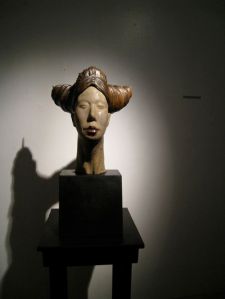
Joel Alonday, "The Disguise"
What a welcome development for the art scene that the creative minds behind Art Informal have decided to devote half of their line up for the year to sculpture exhibits. Already, they’ve chalked up some pretty good ones: glass and stone pieces from Noell El Farol and Mervy Pueblo, works on clay in Himasmas, woodwork
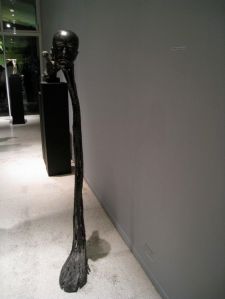
Joel Alonday, "Posporo"
from Riel Hilario. Even more exciting, Joel Alonday, one of the gallery’s prime movers and its resident curator, also the 2008 Metrobank Foundation awardee for Achievement in Sculpture, finally shows his own pieces. Because of his responsibilities in developing AI’s exhibits and conducting its workshops, Joel’s fans and collectors have had to wait three years for this solo appearance.
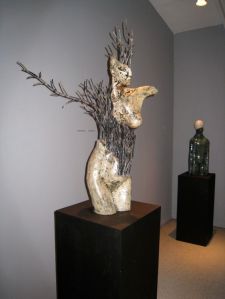
Joel Alonday, "Makiling"
Few of us know that Joel’s background in industrial design led him to a stint as an exporter in the 1980s. Not content with merely developing products for foreign markets, he also learned how to fabricate them. He honed his skills in basketry and sewing, carving wood, welding iron, and working with resin. Eventually, his nine to five job crossed into more creative pursuits. As his firm exported papier mache products in 1987, he joined the art group Hulo and exhibited life-sized papier
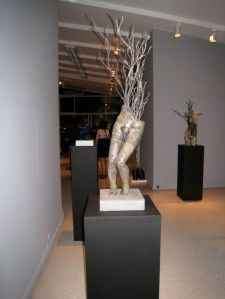
Joel Alonday, "Missing A Leaf"
mache sculpture. It took a few years before his first solo show. In 1994, at the CCP, he presented mixed media assemblages. By 1997, he committed himself fully to sculpture, collaborating with curator Bobi Valenzuela, showing first in Hiraya, then Boston Gallery.
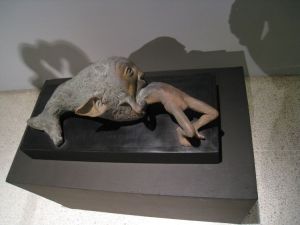
Joel Alonday, "Oh Jonah"
Markings signals a departure for Joel, a break from monumental pieces in cold cast marble. This time, he holds off on busts of our national heroes and denizens of classical mythology. Instead, he takes us on an intimate journey through his personal and artistic life. He works with clay, occasionally combining it with wrought iron, experimenting with different glazes to finish his pieces. He installs his pieces chronologically, grouping together works that recall specific periods and events.
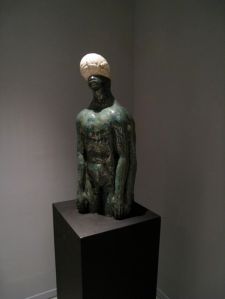
Joel Alonday, "Mortuus Mens"
We begin at the gallery’s foyer. In Fairytale, Joel portrays a mermaid’s tail as a fragile and delicate skeleton, gently curving as if ready to swish. Through its slightness, he illustrates how easily a myth crumbles with the onset of adulthood. He uses locally-sourced clay for this piece, a variety developed by potter Jon Pettyjohn. Mortuus Mens means death of the mind. It is a depiction of the god Shiva, atrophied from the inactivity of its brain. You first notice that this figure wears its brains like a rapper’s skullcap. Its torso has six arms and they hang limply on its side. Before devoting his days to his art, Joel felt brain dead, paralyzed by his daily corporate grind.
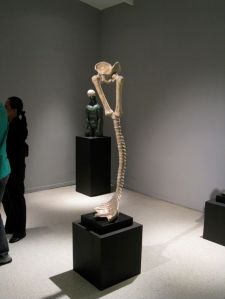
Joel Alonday, "Fairytale"
Joel lets us into his internal struggles with his faith via two pieces. The humorous Mooning portrays the devil burrowing his way back to the underworld with only its long and spiky tail visible to us on earth. Seed takes a more sombre tone, with its bust of Padre Pio, recently canonized, a source of miracles.
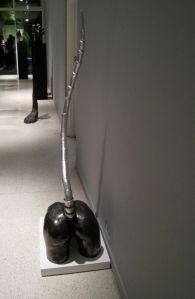
Joel Alonday, "Mooning"
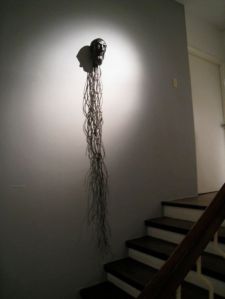
Joel Alonday, "Seed"
My favorite piece, Disguise, speaks of past heartbreak at the hands of women who are not what they seem to be. Lift up her hair and voila, she takes on a different persona. Almost unnoticed, the tips of her wig end in goat horns. Posporo is the last piece Joel finished for this show, at the point when he felt spent and burnt out.

Joel Alonday, "Medusa"
While the tragic events brought on by Typhoon Ondoy make the art scene seem irrelevant for now, it would be a pity to miss out on Joel’s show. After all, we may have to wait another three years for the next one.

Joel Alonday, "Lady By The Sea"
Markings by Joel Alonday runs from 24 September to 24 October 2009 at Art Informal, 277 Connecticut St., Greenhills East, San Juan. Phone (632) 725-8518 or visit http//:www.artinformal.com
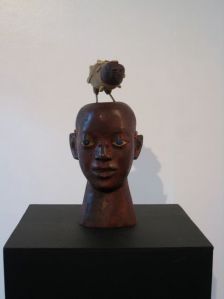
Riel Hilario, "A Piece of Bread: St. Roch"
Riel Hilario does his best work when he goes back to his roots. Trained by santo carvers in his native Ilocos, he revisits this skill in his latest show, Aniwaas, at Art
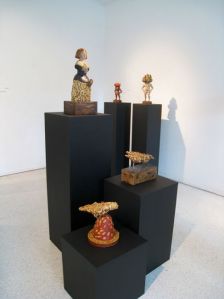
View of exhibit installation
Informal in Greenhills. The Ilocano believes that a person possesses four souls. Aniwaas is that which stays earthbound, not as a ghost but as an imprint that lingers on. The Aniwaas may take the form of animals, tiny creatures like birds and butterflies.
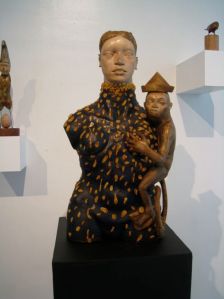
Riel Hilario, "Even Monkeys Fall From Trees"
In this show, Riel exhibits small birds with human faces. These images have recurred in his dreams, that of Santo Niños transformed into birds that retain the Holy Infant’s facial features. Another device that occurs repeatedly in his work, that of disembodied hands, harks to an invisible object, an unseen other that interacts with the piece but remains beyond our visual plane. He uses this in The Wanderer. We also see this in The Reverie of Reason Produces…,his
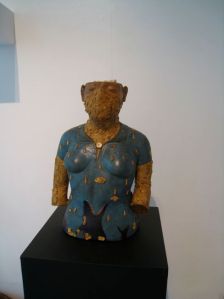
Riel Hilario, "At Sea, One Weekend Journey"
attempt at Velasquez’s Santa Maria Infanta. He injects a dose of humor in The Fire Girl and Better To Burn Out Than Fade Away, his depictions of children with their heads on fire, inspired by witnessing his daughter throwing a tantrum.
The most beautiful pieces, the ones that make us appreciate Riel’s skill the most, are the larger ones: No Longer to Dream But to Be Dreamt Of, Even Monkeys Fall Out of Trees, Flock Birds of the Same: Whispering St. Francis, and the invitation piece, Birds In My Ear, Spectre in My Shoulder. At Sea,
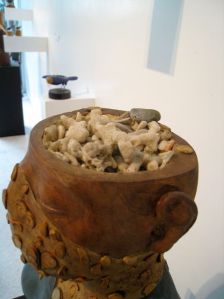
Detail, "At Sea, One Weekend Journey"
One Weekend Journey serves as a receptacle for corals and other found objects from the serene Ilocano seaside at Sitio Remedios.
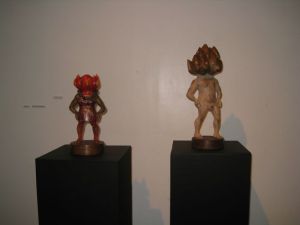
Riel Hilario, "The Fire Girl" and "Better To Burn Out Than To Fade Away"
I first encountered Riel’s pieces at Pinto Gallery in Antipolo, shortly after Kakaduwa, his 2005 solo show at Boston Gallery. Kakaduwa refers to another of our souls, the doppelganger that the Ilocanos believe travels in our sleep. Even then, I could sense his affinity to wood, his instinct for chiseling and bringing this medium to life via pieces that meld his background as a santo carver and contemporary sculptor. I am so glad he’s back, coaxing wood into art.
Riel has left a personal memento inside each one of these pieces. This ritual allows the sculptor to give a part of himself to his work. Thus, true to the show’s title, we can look at these wooden forms as Riel’s own Aniwaas.
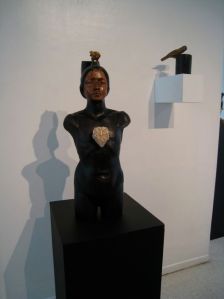
Riel Hilario, "No Longer To Dream But To Be Dreamt Of"
Aniwaas by Riel Hilario runs from 3 to 20 September 2009 at Art Informal, 277 Connecticut St., Greenhills East, San Juan. Phone (632)725-8518 or visit http:// www.artinformal.com
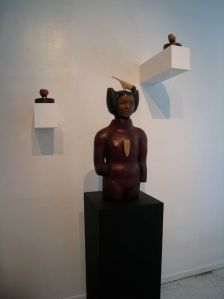
Riel Hilario, "Birds In My Ear, Spectre In My Shoulder"
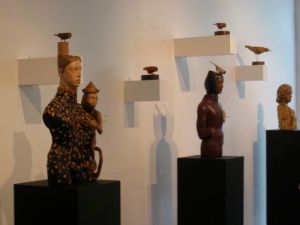
Another view of installation
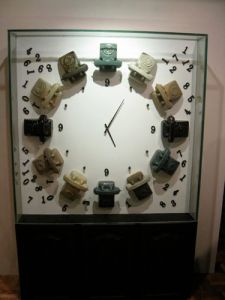
Anna Varona, "Revolution No. 9"
What a terrific coincidence that two leading galleries opened shows this week featuring terracotta and ceramic sculpture, pottery, and other stoneware pieces. What a great opportunity to see works from a cross-section of artists working with clay, from the old established hands of Jon and Tessy Pettyjohn and Julie Lluch, to the Negros sculptors Joe Geraldo and Mark Valenzuela, to up-and-coming artists Anna Varona and Pablo Capati. All the great civilizations, from the Egyptians onward, have molded

Aba Lluch Dalena, "Askal"
earth with their hands. These artists help us appreciate this creative expression today. Continue reading

Leeroy New's colored fiberglass saints (or aliens?)